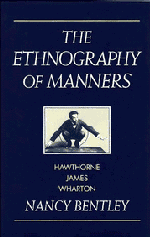2 - Nathaniel Hawthorne and the fetish of race
Published online by Cambridge University Press: 24 October 2009
Summary
Arise and fly
The reeling Faun, the sensual feast;
Move upward, working out the beast.
–Alfred Tennyson, In MemoriamIn an 1862 travel essy about his trip to wartime Washington, Hawthorne compared a group of escaped slaves with mythic fauns. The men and women walking north on a Virginia road, he wrote, “were unlike the specimens of their race whom we are accustomed to see at the North”:
So rudely were they attired, – as if their garb had grown upon them spontaneously, – so picturesquely natural in manners, and wearing such a crust of primeval simplicity (which is quite polished away from the northern black man), that they seem a kind of creature by themselves, not altogether human, but perhaps quite as good, and akin to the fauns and rustic deities of olden times.
This striking fantasy appears in the middle of a narrative piece that Hawthorne wrote in the name of realism. He begins by distinguishing the essay from his fiction, telling of his reluctant turn away from the “fantasies” of romance in order to face the “dread time of civil war”: “I determined to look a little more closely at matters with my own eyes”. Hawthorne takes up a new role as eyewitness, tracking “signs” of war from New England to Virginia.
The fanciful image of a faun, of course, had been central to Hawthorne's most recent romance novel, The Marble Faun, published just over a year earlier.
- Type
- Chapter
- Information
- The Ethnography of MannersHawthorne, James and Wharton, pp. 24 - 67Publisher: Cambridge University PressPrint publication year: 1995



